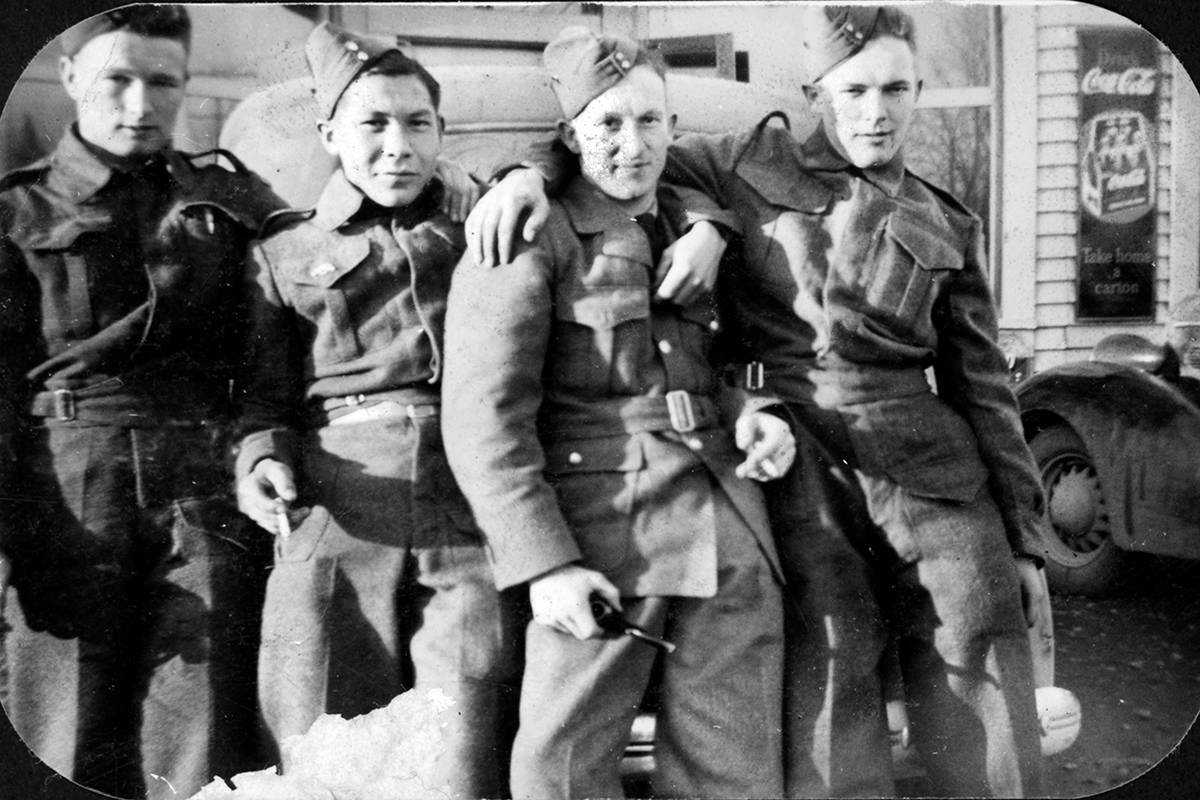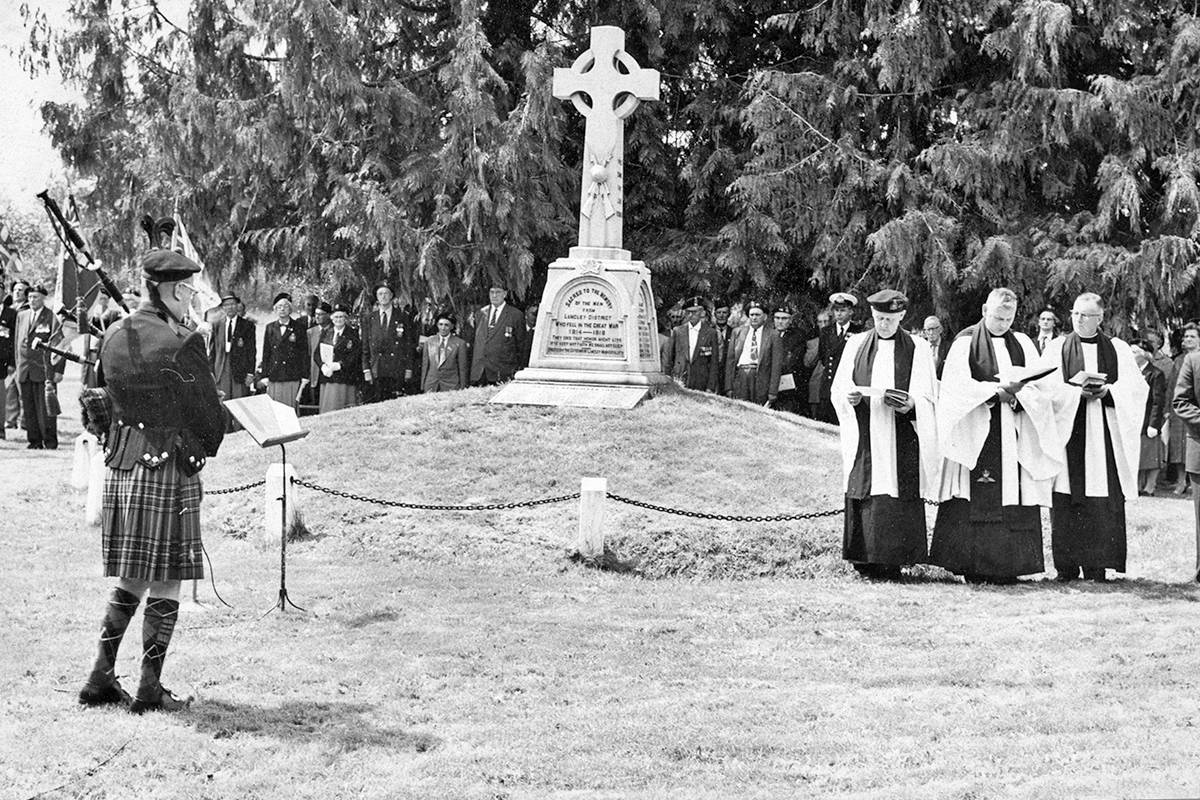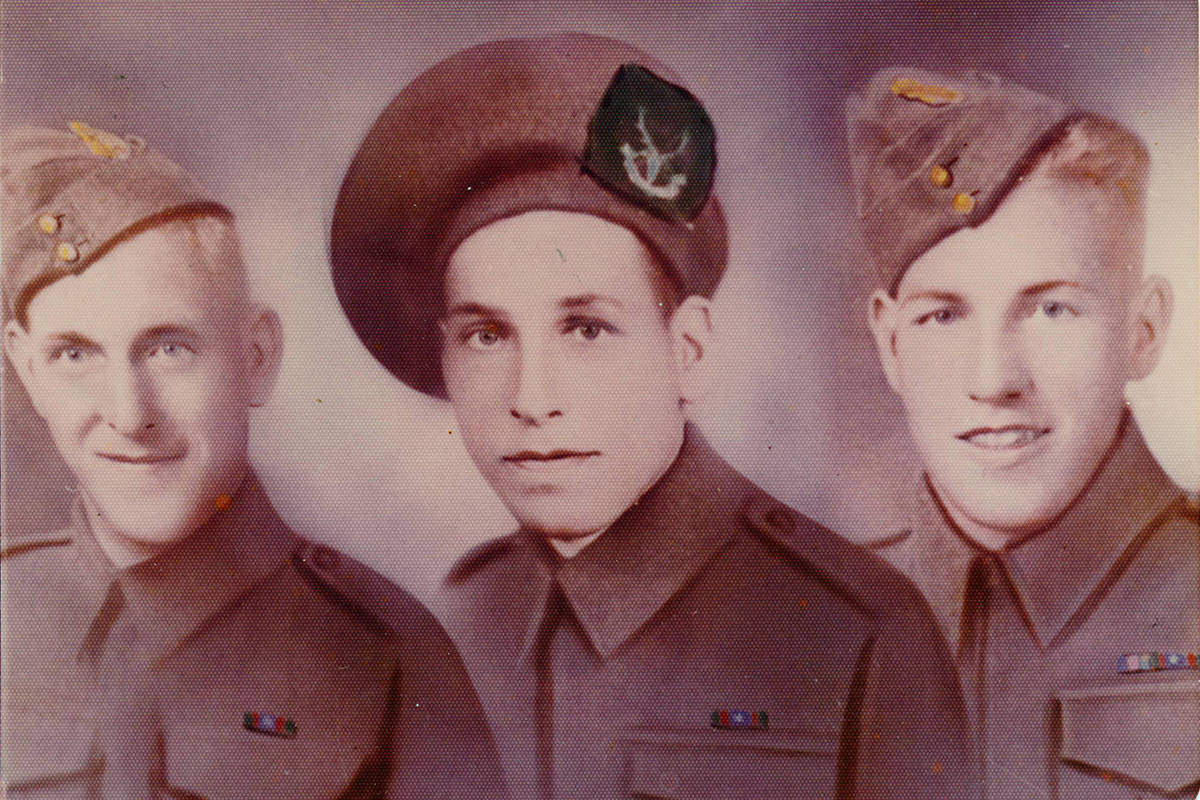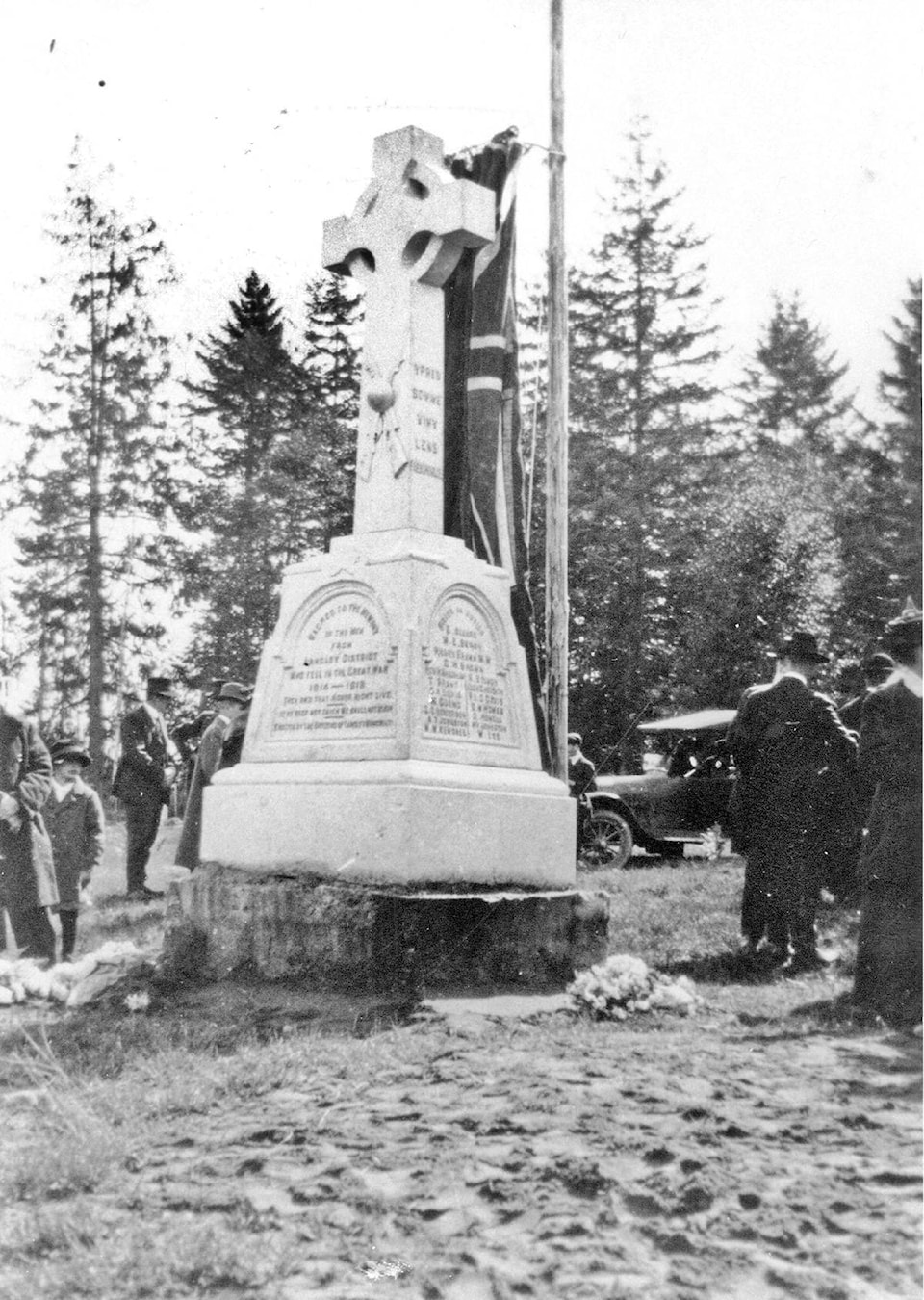by Warren Sommer/Special to the Langley Advance Times
The year 2020 marks the 75th anniversary of the end of the Second World War and the 100th anniversary of the dedication of Langley’s twin war memorials. As Remembrance Day approaches it seems appropriate to have a closer look at Langley’s sacrifices during the two world wars.
When the First World War broke out in August 1914, the combined population of what are now the City and Township of Langley was little more than 3,500. An additional few dozen people lived on the adjacent Kwantlen and Katzie Indian reserves.
Langley residents joined in the war effort with considerable and sustained enthusiasm, with up to one-half of the community’s adult male population serving in uniform at some time during the following four years.
Servicemen’s wives, mothers, and children assisted in their own way: raising funds through a seemingly endless series of bake sales, dances, and concerts; knitting thousands of pairs of socks; sending parcels of tobacco and baked goods to soldiers and sailors serving overseas; and scavenging bits of metal for recycling into armaments and ammunition.
Amid all the patriotic activity there was also anxiety and grief.
Picking up the family’s mail at the local post office gave cause for trepidation, a letter postmarked “Ottawa” potentially announcing a loved one declared missing, wounded, or killed in action.
Although bad news might be received at any time, the majority of ominous letters arrived a few weeks after Canada’s major engagements with the enemy at Vimy Ridge, Passchendaele, and Cambrai.
Sadly, by the time the war had ended one out of every 10 young men who had enlisted from Langley lay buried in France, Flanders, or England.
Despite these losses, the declaration of the armistice that effectively ended the war on 11 November 1918 gave rise to a day of celebration.
Greta (Harrison) Nettleton, then living in Langley Prairie, recalled the time later.
“One night we were awakened by a great clanging of drums, metal pans, and noise makers as people marched up the Yale Road shouting, ‘The war is over! The war is over!’”
Community members gathered at Murrayville’s Five Corners where, as 15-year-old Florence Cassidy recorded, returned soldier Quint Gosling crafted a stuffed Kaiser, “dressed him all up and strung him up on the telephone wires.”
Fort Langley residents celebrated twice, having received news that the armistice would take place on Nov. 10. Undeterred, they gathered at the old fort site for the second night in a row, their ranks swelled by a parade of cars from Milner and Murrayville whose passengers arrived waving flags, hooting their horns, and singing patriotic songs. The celebrations rose to a fever pitch as the entire assembly joined in burning the Kaiser in effigy.
Elated by all the celebratory activity, Florence Cassidy related that people throughout Langley “really did have a bear of a time… I guess we will always be having a big time on the 11th of November every year.”
Despite Florence’s prediction, the anniversary of the armistice did not become a day of annual celebration to mark the end of the war. Too much blood had been shed to warrant any form of merriment. Commemoration, not partying, became the order of the day, not just in Langley, but throughout the nation.
Langley was quick to honour its fallen: commissioning plaques, renaming streets, constructing community halls, and planting memorial trees. Perhaps most importantly, two stone war memorials, each in the form of a Celtic cross, were erected in the municipally owned cemeteries in Fort Langley and Murrayville. The monuments were funded entirely by public subscription, the necessary sum being raised within the span of a week.
The two memorials were unveiled on Sept. 12, 1920, Murrayville’s by a younger brother of deceased airmen Ed and Bill Berry, Fort Langley’s by the two young sons of Private Alfred Trattle (who had been killed in action at Vimy Ridge).
Led by several of the province’s leading clergy and military men, the ceremonies that day were solemn events. Members of the 47th Battalion’s band reunited to supply the music. Residents sang hymns, joined in prayer, and paused to remember the three-dozen young men who had died in uniform and whose names were inscribed on the monuments.
• READ MORE: 36 memorial trees ‘hiding in plain sight’ around Langley
Subsequent services were held in the spring on what was commonly known as Memorial Day. The practice continued until 1931, when federal legislation established Nov. 11 as a day of national remembrance. Hopes remained strong that what had come to be known as the Great War had been the war to end all wars.
It was not to be.
In September 1939 Canada was at war again. More than 650 young men and women enlisted from the still sparsely populated community, not just in the nation’s army and navy, but also in the more recently formed Royal Canadian Air Force.
During the previous war, women had served mainly as nurses. By 1942, their opportunities in the military had increased, each branch of the service having developed a female branch incorporating activities ranging from drafting and driving to cooking and code-breaking. Many young women served in the Canadian Women’s Army Corps, where they were popularly known as CWACs. Some enlisted in the Women’s Royal Canadian Naval Service as “Wrens”; others joined the Canadian Women’s Auxiliary Air Force (CWAAF).
Men who had served in the First World War (such as municipal clerk Archie Payne) often enlisted for home service, some in the armed forces, others in the Air Raid Precaution (ARP), an organization charged with enforcing the nation’s blackout regulations. Still others, including future municipal councillors Bill Poppy and Art Brooks and Murrayville dairy farmer Tom Berry, enlisted in the 63rd Company of the Pacific Coast Militia Rangers, a unit entrusted with protecting the province in the event of a Japanese invasion.
People in uniform became commonplace on Langley’s streets, with dozens being based at the recently established Naval Radio Station in Aldergrove. Members of “C” Company of the Westminster Regiment (including Langley Advance staffer Fred Cox, who subsequently served in the Royal Canadian Air Force) drilled at Langley Prairie’s Amateur Athletic Association Hall.
Airmen training at Ladner occasionally landed their aircraft on the primitive runway at what later became the Langley Regional Airport.
As in the previous war, civilians also did their bit, not the least of which included cultivating produce-bearing Victory Gardens, preparing packages for those serving overseas, purchasing Victory Bonds, and operating a canteen in the Langley Amateur Dramatic Society’s hall.
Langley residents were able to follow the progress of the war as they listened to newscasts on CKNW and CBC Radio or picked up copies of the Vancouver Province or New Westminster Columbian, while the Langley Advance kept readers abreast of activities on the home front.
The Advance also had the grim duty of reporting the community’s losses, whether in the waters of the North Atlantic, in the skies over Germany, in the hills of Italy, in the sands of the Sahara, or on the beaches of Normandy.
By the time the war in Europe ended on May 7, 1945, some41 men from Langley had made the supreme sacrifice, their names later being added to the existing war memorials.
Some families had suffered multiple losses; Fort Langley’s Haddens, Walnut Grove’s Davies, and Coghlan’s Houghs mourned the deaths of two sons each, while Milner’s Kimmels lamented the loss of three, none aged more than 30. One can only try to imagine the grief these families suffered; the Kimmels’ sufferings must have been immense, their sons Richard and Gordon having been killed in Normandy just 10 days apart.
Though conscious of their losses, Langley residents nonetheless gathered to celebrate the hard-earned peace. Sirens wailed from the municipality’s volunteer fire halls. Motorists sounded their horns. Union Jacks, Red Ensigns, and bunting appeared as if from nowhere. There was dancing in the streets. Led by Jimmy Duncan’s pipe and drum band, a quickly organized parade circled Langley Prairie and halted at the corner of Glover Road and the Fraser Highway. The crowd roared its approval as effigies of Adolf Hitler and Benito Mussolini went up in flames. Spectators then made their way to the Murrayville Hall to dance the night away.
The community celebrated again in August when the Japanese surrender officially ended the Second World War.
But the joy was short-lived. As the world began to learn more about the power of nuclear weapons an ominous new era was about to begin.
The 1945 Remembrance Day services must have been especially sombre. Their celebrations over, Langley residents now gathered to honour the dead of not one, but two world wars.
An “iron curtain” had descended across the very continent that Canadians had fought to make free. A new “cold war” had already begun.
Seventy-five years later world peace seems as elusive as ever.
Canadians have lost their lives to conflicts in Korea and Afghanistan, and while serving as peacekeepers elsewhere. Langley’s two original war memorials and the more recently built cenotaphs in Aldergrove and the City of Langley thus continue to be the focus of Remembrance Day observances. Initially held solely to remember the fallen, these services also honour all those who have served in uniform while offering hope that someday war and sacrifice will become relics of the past.
• READ MORE: Langley rejoices: ‘Peace’
________________________________
• Got a news tip. Email us at editor@langleyadvancetimes.com. We look forward to hearing from you. In the meantime, like us on Facebook or follow us on Twitter.



